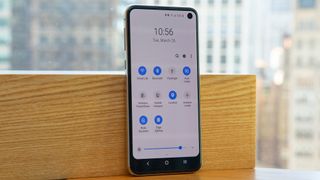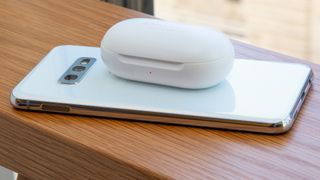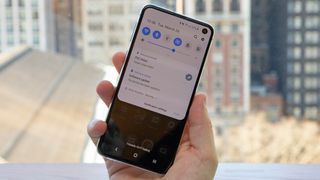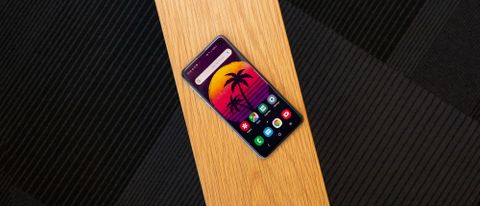Why you can trust TechRadar
Performance
The S10 phones are the first in many markets to feature the new Snapdragon 855 chipset, and will be for some time into 2019. Sure, it would be a surprise if Samsung gimped its ‘essential’ model with an older processor, but it’s still nice to see it get a leading chip, especially after Apple did the same for the iPhone XR. The S10e managed a blistering 10,523 average score on Geekbench 4, if you wanted its performance put to numbers.

The phone’s baseline 6GB of RAM and 128GB of storage will be more than enough for most people — we zipped around the UI swapping apps with abandon and didn’t see a snag. You can upgrade to 8GB of RAM and 256GB of space for a modest price bump (at least in the US), but that’s probably only necessary if you absolutely need more space. If the higher tier isn’t available in your region, you can expand storage with a MicroSD card.
The phone can certainly keep up when gaming, handling Asphalt and Fortnite at highest specifications. Just be aware that playing at the top of its capabilities will drain the battery (an extended Fortnite match zapped 5%) and heat up the phone a bit, too.
Battery
As for the battery, the S10e packs a 3,100mAh unit, which was plenty to get through the day while managing chat apps, email and listening to music. Recharging is quick with up to 15W fast charging (and 15W wireless charging), which isn’t the fastest-wattage charging on the market, but it gets the job done.
And you might need to top up a bit more often if you’ve got other wireless devices – because now, the S10e can charge them itself thanks to a new feature: Wireless PowerShare.

Wireless PowerShare
One of the S10 series tricks that hasn’t been snipped out of the S10e is pretty exciting...if you’ve got devices to use it. Essentially, you can use your S10e to wirelessly charge other devices that have Qi-enabled charging thanks to a new feature called Wireless PowerShare (a far better name than Reverse Wireless Charging, which is what Huawei chose when it debuted the perk in the Huawei Mate 20 Pro in late 2018).
In theory, the Wireless PowerShare feature is simple: turn it on, place the second device on the rear cover of the S10e, and wait. Sadly, wireless charging speeds are still slow, so you’ll have to leave your Samsung phone alone if you want to transfer battery power to another device.
In practice, it’s not too hard to figure out. You can manually turn PowerShare on by digging around in the settings, though Samsung helpfully put a shortcut in the easy-access drop-down settings window. You’ll have to place the device in the exact center of the S10e’s rear cover for it to charge, though the phone will buzz once to let you know when it’s donating juice (and double-buzz when the receiving device has moved out of the recharging zone).
It’s an awesome feature, though probably not one you’ll use a lot (save for nobly sacrificing some charge to revive a mate’s low-power phone). But Samsung did suggest a novel use case: plug your S10e in to a wall charger, activate PowerShare and use your phone to recharge a second device (like, say, Samsung’s new Galaxy Buds) overnight. Voila, only one wall outlet used.
Let’s say you did that and, oops, the wall plug fell out, but your S10e was still charging another device. Will your phone die while pumping charge out? No, thankfully: Samsung introduced a failsafe that turns off PowerShare once the donating phone hits 30% charge. Heck, you can’t even turn on the feature until you charge the S10e back up above that threshold.

What’s it like to use?
Now is the time for this reviewer to admit his bias: after stubbornly refusing to upgrade his iPhone 6S until very recently, he finds most large phones grotesque handfuls. The S10e is a perfect substitute for that Apple phone, almost uncannily identical in size despite its larger screen (thanks to smaller bezels).
From that perspective, the S10e is a pleasantly-sized phone that’s just small enough to use one-handed. Admittedly, if this category of sub-6-inch phones weren’t so sparse, we’d be a bit less starry-eyed, but it’s also true that Samsung’s interface works even better in such a compact frame.
Some of that is thanks to One UI, Samsung’s recent overhaul of its UI overlay, which has placed most things you need helpfully low and right-aligned where your thumb is likely to hover. You can switch things around (like for the Edge panel) if you fiddle with the settings, which have been reshuffled into fewer broad categories that become more specified if you delve deep enough.
As expected, the S10e gets Android 9 Pie out of the box (along with One UI), so you’ve got the latest and greatest mobile OS. Since it’s part of a flagship series, the S10e may be one of the first of the company’s phones in line when Android Q is released, which will likely be far later in the year – given how slow Samsung is to update its phone, plenty of other devices will probably get the upgrade first.
Samsung claims that they’ve harnessed AI to optimize performance, and we’re inclined to agree, as it’s pretty effortless to zoom around the interface. Slightly cooler are the other things Samsung’s done with AI, like Bixby Routines, which take certain actions when a condition triggers, IFTTT-style. You can set these up manually, but the phone should start learning your habits and suggest ‘routines’ unique to you, Samsung claims. (We weren’t prompted to set any, so it might need more time with the phone or more AI tweaking.)
Media-wise, the S10e has more in favor than complaint. True, its smaller size means less screen real-estate to watch videos, and it’s noticeably deficient when placed side-by-side with a Plus/Max-sized flagship phone. It’s gaming where the diminutive form factor takes the greatest hit, and your thumbs will cover up precious screen space on either side where more active games typically house their controls. If you’re playing a game where every edge matters – like, say, in Fortnite – you’ll be a little hampered compared to players on bigger phones.
Size aside, it’s a good phone for enjoying less frenetic media, with things like a video enhancer feature to make things you watch more comprehensible (read: evenly-lit). An accessible headphone jack only makes the experience better and the speakers (in the earpiece and bottom edge) boast respectable volume, though you’ll get more nuanced audio out of Apple’s flagships.

John joined TechRadar over a decade ago as Staff Writer for Phones, and over the years has built up a vast knowledge of the tech industry. He's interviewed CEOs from some of the world's biggest tech firms, visited their HQs and has appeared on live TV and radio, including Sky News, BBC News, BBC World News, Al Jazeera, LBC and BBC Radio 4. Originally specializing in phones, tablets and wearables, John is now TechRadar's resident automotive expert, reviewing the latest and greatest EVs and PHEVs on the market. John also looks after the day-to-day running of the site.

